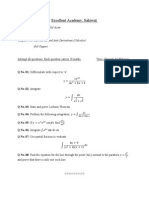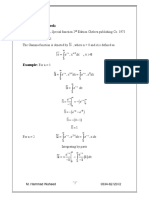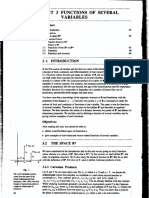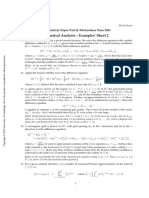Greens Function
A Green's function is an integral kernel that can be used to solve an inhomogeneous
differential equation with boundary conditions. It serves roughly an analogous role in partial
differential equations as do Fourier series in the solution of ordinary differential equations.
In the modern study of linear partial differential equations, Green's functions are studied
largely from the point of view of fundamental solutions instead. It is named in honour of
English mathematician & physicist George Green (1793-1841).
Homogeneous vs. inhomogeneous differential equations
A linear differential equation is homogeneous if every term contains the dependent variable
or its derivatives.
A homogeneous differential equation can be written as where L is a linear
differential operator.
A homogeneous differential equation always has a trivial solution y(x) = 0.
Superposition principle: If y
1
(x) and y
2
(x) are solutions to a linear homogeneous differential
equation, then ay
1
(x) +by
2
(x) is a solution to the same equation.
An inhomogeneous differential equation has at least one term that contains no dependent
variable.
Inhomogeneous equations are often called driven equations. They describe the response of
the system to an external force.
The general solution to a linear inhomogeneous differential equation can be written as the
sum of two parts:
Here y
h
(x) is the general solution of the corresponding homogeneous equation, and y
p
(x) is
any particular solution of the inhomogeneous equation.
Nonhomogeneous equation Greens function
A nonhomogeneous linear differential equation can be written as
x x y x
dx
x dy
4 ) (
) (
2
= +
t A x x x e e sin
2
0
= + +
) ( ) ( ) ( x y x y x y
p h
+ =
0 ) ( 4
) ( ) (
2
2
2
= + + x xy
dx
x dy
x
dx
x y d
x
dx
d
x
dx
d
4 e.g.,
2
2
2
+ + = L
where , 4 e.g.,
2 2
a
dr
d
r + + V = L
, 0 ) ( = x y L
L = Linear differential operator
y(r) = Field to be found (response)
f (r) = Source function (driving force)
Because of the linearity of the equation, if f (r) can be decomposed into a series of function
f (r) =
i
f
i
(r), with each f
i
(r) causes a field of y
i
(r), i.e., then the solution of
the original differential equation will be y
1
(r) + y
2
(r)+
We also know that any source function f (r) can be decomposed into a number of d functions
by . Therefore if we can find the solution of the
Greens function then solution of the original differential equation
will be
Proof:
Notes to Greens functions:
1) The Greens function G(r, r') can be thought as the field distribution at r caused by a
point source located at r'.
2) Since any source function is a sum of many point sources, the actual solution of a
nonhomogeneous linear differential equation is a superposition of the Greens
function caused by each of the point sources.
3) The Greens function is not one specific function. It is problem-specific, depending on
the initial differential equation we are asked to solve.
Examples of Greens functions:
1) Electrostatics.
| | ). ( ' ) ' ( ) ' ( ' ) ' ( ) ' , ( ' ) ' ( ) ' , ( ) ( r r r r r r r r r r r f d f d f G d f G y
} } }
= = = = t o t t L L L
. '
'
) ' (
4
1
'
) ' (
' 4
1
) (
' 4
1
) ' , (
) ' ( ) ' , (
) (
) (
0 0
2
0
2
} }
=
(
|
|
.
|
\
|
=
= V
= V
t
tc
t
c
t
o
c
d d
G
G
r r
r r
r r
r
r r
r r
r r r r
r
r
), ( ) ( r r
i i
f y = L
}
= ' ) ' ( ) ' ( ) ( t o d f f r r r r
), ' ( ) ' , ( r r r r =o G L
) ( ) ( r r f y = L
. ' ) ' ( ) ' , ( ) (
}
= t d f G y r r r r
2) Falling objects. An object is dropped at t =0.
Though this seems to be cumbersome, it can be directly applied to solve a varying force
problem. The power of Greens function is then revealed:
3) Imaging process. How a camera works. The Greens function for a point source is
called a point-spread function, which is usually an Airy spot with some rings. The
image is a superposition of the point-spread function, weighted by the source
intensity. Though I do not know the actual differential equation involved.
2
0
0
'
'
'
'
2
1
'
'
' ) ' , ( ) (
,
'
' , 0
) ' , (
theorem) impulse - (momentume
,
1
' , 0
) at received impulse (unit 1 ) ' (
) ' (
) (
gt mgdt
m
t t
mgdt t t G t y
t' t
m
t t
t t
t t G
t' t
m
t t
G
t' t dt t t G m
t t G m
mg t y m
t
t
t
t
t
t
=
=
=
>
<
=
>
<
=
= = =
=
=
}
}
}
+
c
c
c
c
o
o
} }
= = =
t t
dt t f
m
t t
dt t f t t G t y t f t y m
0 0
' ) ' (
'
' ) ' ( ) ' , ( ) ( ) ( ) (
} }
+
+
= ' ' ) ' , ' ( ) ' , ' ; , ( ) , ( dz dy z y S z y Z Y G Z Y I






















































































